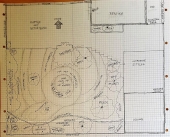I found this forum via Google when I was (very casually) researching hugelkultur, and after lurking a bit (and finding myself quite intimidated by most of you permies and your much more sophisticated knowledge than mine about so many topics ), I realized this site would be more beneficial and a lot more fun if I participated. So, here I am.
I am not "into" permaculture, per se...I've never taken a course, I don't know the principles, I don't have the slightest idea what one does to convert to permaculturist. I was raised in gardens...my mother always kept a kitchen garden, but my grandmother was the real green thumb with all of her bulbs and cut flowers and extensive veggie plot. It was the 80s. We weren't organic. Far from it, as we were in 4-H and sustainable, small-scale wasn't even on university radar back then. I didn't learn about organic until I attended a (very permaculture-ish) camp in the early 90's, and even then the curriculum was way ahead of its time. But it stuck.
I've been gardening (on my own) with enthusiasm (and using organic methods) for the past 11 years. I've also had the good fortune to work in the gardens of some "real" permaculture types during that time, which taught more than any formal education in agriculture could have at the time. I don't use any particular method or adhere to a specific garden dogma. I feel that regardless of what you are growing and how you are growing it, you're basically designing a system. I've read a ton of books (but not nearly enough) and I'm a big fan of John Jeavons' Biointensive model and Eliot Coleman's year round harvest techniques. I'm passionate about raised beds, prefer a no till approach, and I despise double digging...but that's because I'm disabled and not because they're the "right" way to do it. I just design my systems around those parameters because otherwise I'm not going to be able to garden. Limited energy and chronic pain are a driving force behind making every aspect of my edible landscaping as efficient as possible, so I'm always looking for ways to improve water consumption, eliminate weeding, and make the soil do the work.
I'm currently renting a very humble house on the more urban outskirts of a suburban sprawl, but it's on about 2 acres, partially wooded. The landlord said I could make my garden as big as I wanted and the property manager loves my heirloom tomatoes, so I'm lucky in that regard. This "lawn", though 😳. I love being in an ecologically diverse setting, and this lot is downright riparian, but we're also the low point for half of the neighborhood and have the privilege of receiving their massive amounts of runoff when it rains. Even without that additional ground saturation, the contours of the yard were poorly considered and it floods to the point of being unusable for anything but growing rice during the rainy season. And native "weeds" and grasses. It grows those great, and by the time the waters subside so you can chop them down, you have some great mulch/compost materials. Except that about a third of those nitrogen harboring beauties have been allowed to grow up through the old gravel drive that the property owner decided to quit maintaining so that people would quit using the yard as a turn around. The rocks (jagged crushed granite?) wreak havoc on mower blades, trimmer string, and my legs.
So, my current project is smothering that entire area of the yard under 12" of wood chips. The secondary goal of the chips is to absorb excess moisture, direct runoff, and minimize pooling. Apparently there's a "method" of using wood chips to garden, but that's not what I'm doing. In some regards, the science is the same because I AM trying to build the soil in that spot, but the chips are there to elevate that area so that I have a foundation for my garden beds and other elements. That the chips readily
compost down into good soil is just an added benefit to the system 😉. We'll see how that works out.
Anyway, it's really nice to have found this community, and I'm really glad to be here.
Missy









